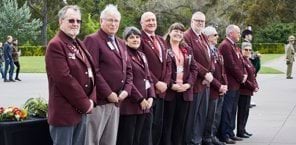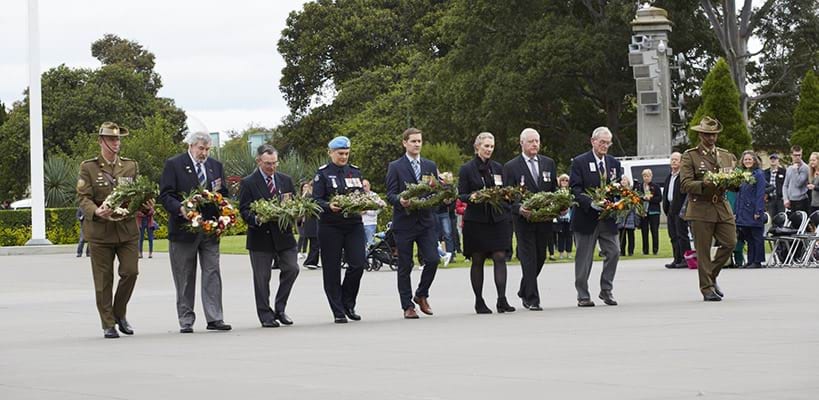
- Conflicts:
- First World War (1914-18), Second World War (1939-45)
- Services:
- Army, Air Force
by Laura Carroll
Well, I’ll start off with our greatest adventure’ says Mac, glancing conspiratorially at Peter. ‘And that was paddling a blow-up canoe down the Goulburn River, from Eildon to Alexandra. Beautiful day, but we ran into some concealed barbed wire, and we had to swim for it.’ Peter laughs and nods. ‘I remember we were carrying oranges, and I saw them floating away from us.’ Australia was a different place in the 1960s. Emergency services were not called; the canoe was patched and the expedition continued. The intrepid sailors reached their destination many hours late, and Peter’s new girlfriend Janet, who was also there as part of her first visit with the extended family, didn’t change her mind about marrying into the Ford-Geddes clan.
Peter was in his late twenties that day on (and in) the river and Mac was twenty years older. It was one moment in a long and rich shared story which starts with Peter’s birth during the Second World War—while his father Vic was on active service in New Guinea and Mac was serving as a member of Air Force ground crew—extending right into the present day. Both men are long-standing volunteers at the Shrine. Between them they have spent 24 years sharing with visitors the powerful and moving stories of their own and their relatives’ sacrifices in war beginning with five lives lost in the First World War, one of them at 8am on 25 April 1915, and another who bequeathed his name, Mackinlay, to the nephew who would be born years after the war ended.
When he was seven or eight years old, Peter’s mother Betty kissed her firstborn on the cheek and put him alone onto a McKenzie’s bus at Ringwood—’I think I sat up the front next to the driver’, he says—to spend a school holiday with Mac and his wife Katrina at Rubicon ‘A’, a State Electricity Commission (SEC) village of 16 cottages housing workers servicing Australia’s first state-owned hydroelectric scheme. Peter remembers how fascinating it was to observe Mac, who was a paymaster for the SEC, depositing a generous amount of tomato sauce on every piece of food on his dinner plate, and how the family played cribbage round the table in the evenings. He recalls the wild freedom of bush adventures outdoors with his cousins, and most of all, the unquenchable thrill of a ride in the windlass-powered unroofed tramway known as ‘The Haulage’, which carried SEC workers up the rugged mountainside to the power station. Mac and Katrina spent fourteen extremely happy years at Rubicon ‘A’. Their children Mandy and David were born there, and Mac remembers summers in the swimming pool and winter dances in the hall, both facilities built by the community. The Fords moved on when their children’s education required access to different schools.
While Peter was growing up, the extended family took camping holidays together at Easter time. He remembers Mac taking charge of operations from the setting up of the big tents to the gathering of firewood. ‘you were the leader’, he says. Mac oversaw the construction of enormous bonfires by the Redbank Weir outside of Balranald on the Murrumbidgee River, where the family dined on steaks, potatoes, peas and freshly caught fish. ‘you were in charge of the Glühwein’ Mac adds. Glühwein, for those not in the know, is a German mulled claret: pretty alcoholic, Peter says, and spicy.
Like all good family narratives, the Ford-Geddes story contains revealing moments connected with eating and drinking. I asked Mac what he recalled of how his sister Betty managed when Peter, her first child, was born and her husband Vic was serving overseas. Mac explained that when he returned to Melbourne from the Air Force base at Mallala in South Australia, he advised Betty, a nurse, to ensure her baby received ‘plenty of orange juice and ice-cream’, as Mac understood these foods to be very good for infants; however, ‘she didn’t take any notice of me’ he remembers.
Mac’s working life began early by today’s standards. He enlisted in 1943, aged seventeen, and through the tumultuous years which followed, he worked in crews keeping Catalinas and Liberators aloft in Pacific skies, making lifelong friends and setting a pattern of resilience and adaptability which many would say is a hallmark of the generation of people who came of age in the Second World War. In Mac’s case, it’s also evident that he has one of those personalities which thrives on adventures.
Mac’s practice of tendering bold advice to his relatives bore significant fruit when Peter retired, around ten years ago, and Mac suggested Peter join the Shrine’s volunteer guide workforce, which Mac had already been involved with for ten years. ‘My uncle told me’, said Peter, ‘“this is what you’ll do.”’ For Peter, the suggestion resonated with his long-standing interest and pride in his father Vic’s wartime service, and his growing conviction that the profound achievements of prior generations of Australians should be talked about and not forgotten.
Peter’s father Victor Geddes enlisted in October 1939 and was discharged the same month in 1945. His four brothers also enlisted and all returned. Growing up, Peter was aware that Vic’s service number, VX614, was low, and that he had participated in many of the most famous episodes in Australian wartime history. ‘One of Dad’s best mates was known as Snowy. They were in Crete. He and Dad became separated in a clump of trees, and Snowy was captured and became a prisoner of war.’ Snowy was liberated before the end of the war and made it home before Vic. Peter’s mother’s diary (now in the collection of the State Library of Victoria) records a visit from Snowy where he helped out by sitting on the floor, long skinny limbs going in every direction, and washed Peter in a tin bath. Vic’s regiment took part in the celebrated action of Australian and New Zealand troops at Brallos Pass, Greece, fighting a rearguard battle against invading German forces. Mac remembers Vic as a dedicated soldier, but also as a husband who supported his wife’s nursing career by looking after the children so she could work on weekends. ‘I had no brothers, but I always said I had a wonderful brother-in-law’ Mac reflects.
Mac’s father and many of his uncles served in the First World War. One uncle lost his life at Pozières; Mac’s father was decorated for bravery near the same battlefield, but he would not speak to Mac of what he’d done. It was a friend who eventually told Mac about desperate dashes into No Man’s Land to repair shell-damaged communication cables. He was gassed at Passchendaele but returned to Australia to take up a soldier-settler allotment in rural Victoria.
Mac’s parents were already engaged when they parted at Station Pier. I have heard many stories about loved ones separated by the First World War, but an involuntary shiver runs down my spine as Mac describes how ‘the streamer between my future mother and father was the very last one to break, which was always considered a very good omen for the man to come back.’ The couple were married in Ringwood in 1919.
Near the end of our conversation I ask Peter and Mac what they gain from their time spent at the Shrine, where they explain the purpose of the building to curious visitors of all ages and nationalities. Both men reflect on the honour and privilege and occasional deep sadness of being at close quarters with visitors in the Sanctuary when those visitors are remembering the sacrifices made by people dear to them. Mac recalls witnessing a man weep bitterly as he remembered holding his dying brother in his arms at Normandy. ‘That was an emotional day’ he says, looking hard into the distance. Peter simply says ‘I tell school kids about Mac’s dad and uncle at Pozières.’
The Shrine is a focal point and carrier of the memories of Victorian service and sacrifice, and Shrine volunteers such as Mac and Peter play an essential role in unfolding these stories: sharing stories such as these with visitors, and hearing their stories in return.
Author:
Dr Laura Carroll is the Education and Volunteer Manager at the Shrine of Remembrance and an Honorary Research Associate in the College of Arts, Social Sciences and Commerce at La Trobe University.
Updated

